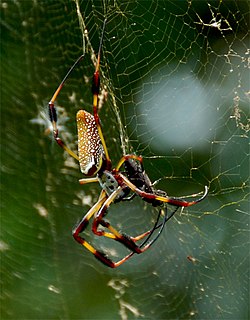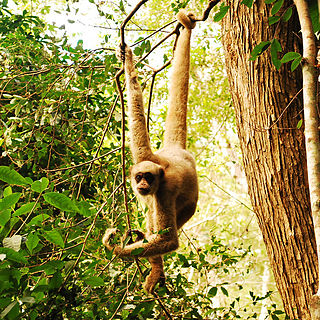
Tobias Vincent Maguire is an American actor and film producer. He is best known for his role as Peter Parker / Spider-Man in Sam Raimi's Spider-Man trilogy (2002–2007). His other major films include Pleasantville (1998), Ride with the Devil (1999), The Cider House Rules (1999), Wonder Boys (2000), Seabiscuit (2003), The Good German (2006), Brothers (2009), and The Great Gatsby (2013).

Arachnology is the scientific study of spiders and related animals such as scorpions, pseudoscorpions, and harvestmen, collectively called arachnids. Those who study spiders and other arachnids are arachnologists. More narrowly, the study of spiders alone is known as araneology.

Wolf spiders are members of the family Lycosidae, from the Ancient Greek word "λύκος" meaning "wolf". They are robust and agile hunters with excellent eyesight. They live mostly in solitude and hunt alone, and do not spin webs. Some are opportunistic hunters pouncing upon prey as they find it or even chasing it over short distances. Some wait for passing prey in or near the mouth of a burrow.

Jumping spiders or the Salticidae are a family of spiders. As of 2019, it contained over 600 described genera and over 6000 described species, making it the largest family of spiders at 13% of all species. Jumping spiders have some of the best vision among arthropods and use it in courtship, hunting, and navigation. Although they normally move unobtrusively and fairly slowly, most species are capable of very agile jumps, notably when hunting, but sometimes in response to sudden threats or crossing long gaps. Both their book lungs and tracheal system are well-developed, and they use both systems. Jumping spiders are generally recognized by their eye pattern. All jumping spiders have four pairs of eyes, with the anterior median pair being particularly large.
Tarantella is a group of various folk dances characterized by a fast upbeat tempo, usually in 6
8 time, accompanied by tambourines. It is among the most recognized forms of traditional southern Italian music. The specific dance-name varies with every region, for instance tammurriata in Campania, pizzica in the Salento region, and Sonu a ballu in Calabria. Tarantella is popular in Southern Italy and Argentina. The term may appear as tarantello in a linguistically masculine construction.

Huntsman spiders, members of the family Sparassidae, are known by this name because of their speed and mode of hunting. They are also called giant crab spiders because of their size and appearance. Larger species sometimes are referred to as wood spiders, because of their preference for woody places. In southern Africa the genus Palystes are known as rain spiders or lizard-eating spiders. Commonly they are confused with baboon spiders from the Mygalomorphae infraorder, which are not closely related.

Latrodectus is a broadly distributed genus of spiders with several species that, together, are referred to as true widows. This group is composed of those often loosely called black widow spiders, brown widow spiders, and similar spiders. However, such general "common names" are of limited use as the diversity of species is much greater. A member of the family Theridiidae, this genus contains 32 species, which include several North American "black widows". In addition to these in North America are also the red widow Latrodectus bishopi and the brown widow Latrodectus geometricus, which, in addition to North America, has a much wider geographic distribution. Elsewhere, others include the European black widow, the Australian redback black widow, several different species in Southern Africa that can be called Button spiders, and the South American black widow spiders. Species vary widely in size. In most cases, the females are dark-coloured, but some may have lighter bodies or even reddish. Many can have red, white or brown markings on the upper-side (dorsal) of the abdomen. Some can be readily identifiable by reddish markings on the central underside (ventral) abdomen, which are often hourglass-shaped.

The Araneomorphae are an infraorder of spiders. They are distinguished by having chelicerae (fangs) that point diagonally forward and cross in a pinching action, in contrast to the Mygalomorphae, where they point straight down. Most of the spiders that people encounter in daily life belong to the Araneomorphae.

Lynx spider (Oxyopidae) is a family of araneomorph spiders first described by Tamerlan Thorell in 1870. Most species make little use of webs, instead spending their lives as hunting spiders on plants. Many species frequent flowers in particular, ambushing pollinators, much as crab spiders do. They tend to tolerate members of their own species more than most spiders do, and at least one species has been identified as exhibiting social behaviour.

The Pholcidae are a family of araneomorph spiders. The family contains over 1,800 pholcids, including those commonly known as the marbled cellar spider , daddy long-legs spider, granddaddy long-legs spider, carpenter spider, daddy long-legger, vibrating spider, gyrating spider, long daddy, and skull spider. The family, first described by Carl Ludwig Koch in 1850, is divided into 94 genera.

Orb-weaver spiders are members of the spider family Araneidae. They are the most common group of builders of spiral wheel-shaped webs often found in gardens, fields and forest. "Orb" can in English mean "circular", hence the English name of the group. Araneids have eight similar eyes, hairy or spiny legs, and no stridulating organs.

Spider monkeys are New World monkeys belonging to the genus Ateles, part of the subfamily Atelinae, family Atelidae. Like other atelines, they are found in tropical forests of Central and South America, from southern Mexico to Brazil. The genus contains seven species, all of which are under threat; the brown spider monkey is critically endangered. They are also notable for their ability to be easily bred in captivity.

The muriquis, also known as woolly spider monkeys, are the monkeys of the genus Brachyteles. They are closely related to both the spider monkeys and the woolly monkeys. The two species are the southern and northern muriquis. They are the two largest species of New World monkeys, and the northern species is one of the most endangered of all the world's monkeys.

Tord Tamerlan Teodor Thorell was a Swedish arachnologist.

The white-bellied spider monkey, also known as the white-fronted or long-haired spider monkey, is an endangered species of spider monkey, a type of New World monkey. It is found in the north-western Amazon in Colombia, Ecuador, Venezuela, Peru and Brazil, ranging as far south as the lower Ucayali River and as far east as the Branco River. In the past, the Peruvian, brown and white-cheeked spider monkeys have been treated as subspecies of A. belzebuth. As presently defined, the white-bellied spider monkey is monotypic. It has a whitish belly and a pale patch on the forehead, which, despite its common name, often is orange-buff. They live in groups of 20 to 40 individuals, splitting into small parties of 1 to 9 when in activity.

Geoffroy’s spider monkey, also known as the black-handed spider monkey or the Central American spider monkey is a species of spider monkey, a type of New World monkey, from Central America, parts of Mexico and possibly a small portion of Colombia. There are at least five subspecies. Some primatologists classify the black-headed spider monkey, found in Panama, Colombia, and Ecuador as the same species as Geoffroy's spider monkey.

Tarantulas comprise a group of large and often ″hairy″ spiders of the family Theraphosidae. Currently, about 1,000 species have been identified. The term tarantula is usually used to describe members of the family Theraphosidae, although many other members of the same infraorder (Mygalomorphae) are commonly referred to as "tarantulas" or "false tarantulas". Some of the more common species have become popular in the exotic pet trade. Many New World species kept as pets have urticating hairs that can cause irritation to the skin, and in extreme cases, cause damage to the eyes.
Ludovico di Caporiacco was an Italian arachnologist.

Spiders are air-breathing arthropods that have eight legs, chelicerae with fangs generally able to inject venom, and spinnerets that extrude silk. They are the largest order of arachnids and rank seventh in total species diversity among all orders of organisms. Spiders are found worldwide on every continent except for Antarctica, and have become established in nearly every habitat with the exceptions of air and sea colonization. As of July 2019, at least 48,200 spider species, and 120 families have been recorded by taxonomists. However, there has been dissension within the scientific community as to how all these families should be classified, as evidenced by the over 20 different classifications that have been proposed since 1900.
Spintharus leonardodicaprioi is a species of theridiid spider. It is found in the Dominican Republic and was named after the actor Leonardo DiCaprio for his environmental activism. It was named alongside several other Spintharus species whose specific epithets honored celebrities, and it received media coverage from around the world due to its name.
















